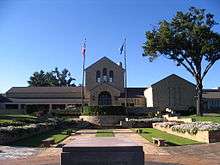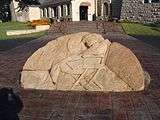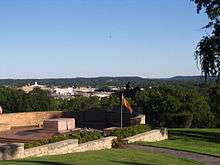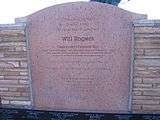Will Rogers Memorial
The Will Rogers Memorial Museum is a 19,052-square-foot (1,770 m2) museum in Claremore, Oklahoma that memorializes entertainer Will Rogers. The museum houses artifacts, memorabilia, photographs, and manuscripts pertaining to Rogers' life, and documentaries, speeches, and movies starring Rogers are shown in a theater.[1] Rogers' tomb is located on its 20-acre (8 ha) grounds overlooking Claremore and Rogers State University.
 | |

| |
| Established | 1938 |
|---|---|
| Location | Claremore, Oklahoma |
| Coordinates | 36.32087°N 95.63149°W |
| Type | History and art museum |
| Director | Tad Jones |
| Website | www.willrogers.com |
Until March 7, 2016, the museum was managed by the Will Rogers Memorial Commission, a state agency. On that date, the Governor of Oklahoma signed legislation dissolving the state commission and transferring the property and all its assets to the Oklahoma Historical Society, another state agency.
History

Will Rogers was born near Oologah, Oklahoma, where his father had settled. He had originally purchased the land in 1911, a plot containing 20 acres (8.1 ha) that overlooks the Tiawah Valley, as the site of his retirement home. The price was reportedly $500 per acre. After his death, it was passed on to members of the Rogers family. Will's widow, Betty Rogers, donated the property in 1937, during the Great Depression, to the state of Oklahoma.[2]
The Oklahoma legislature appropriated $200,000 for the construction of a museum honoring Rogers. The original 15,000-square-foot (1,400 m2) limestone building was designed by John Duncan Forsyth. Groundbreaking occurred April 21, 1938, with Will's sister, Sallie Rogers McSpadden, turning the first spadeful of dirt. Construction was completed November 4, 1938, on what would have been Rogers' 59th birthday.[3] The museum opened in 1938, three years after Rogers' death.[4]
An 11,000-square-foot (1,000 m2) addition was constructed in 1983.[3]
Interior
The rotunda contains a famous sculpture of Will Rogers by artist Jo Davidson. The pedestal is inscribed with a famous quotation by Rogers, "...I never met a man I didn't like." The statue is another cast of the work that the artist created in 1938 and which has represented the state in the National Statuary Hall at the United States Capitol.[3]
The 1983 addition includes a large library and offices that serve as research areas for scholars and writers. This area covers 2,400 square feet (220 m2) and holds more than 2000 volumes relevant to Will Rogers, plus other topics such as Indians, genealogy, vaudeville, early motion pictures. and history of the 1879–1935 era. Museum archives also contain an estimated 18,000 photographs, as well as thousands of original manuscripts, private letters, contracts, and personal papers, as well as motion pictures, home movies, and audio tapes.[3]
Exterior
The tomb of Will Rogers is outside the building, and overlooks the city of Claremore. Other family members interred there are Rogers' wife, Betty (1879–1944), three of their four children: Fred Stone Rogers (1918–1920), Mary Amelia Rogers Brooks (1913–1989), and James Blake (Jim) Rogers (1915–2000). Jim's wife, Marguerite Astrea Kemmler Rogers (1917–1987) as well as Jim's oldest son, James Kemmler (Kem) Rogers (1939–2014) are also interred there.[3] [lower-alpha 1]
Merger with the Oklahoma Historical Society
On March 7, 2016, Governor Mary Fallin signed Senate Bill 1570 into law, which put the Will Rogers Memorial Commission, which governed both the Will Rogers Memorial Museum and the Dog Iron Ranch, Will Rogers' birthplace in Oologah, under the control of the Oklahoma Historical Society. The new law became effective immediately.[6]
There was little opposition to the merger, which was unanimously approved by the Joint Appropriations Budget Committees of both the Oklahoma House of Representatives and the Senate. Tad Jones, director of the Memorial, noted that the Memorial had previously been targeted by political budget cutters for several years, and a bill had been introduced during the previous year to eliminate state contributions to the museum. He expressed a belief that the merger would reduce pressure to cut the museum's funding.[7]
The merger was enthusiastically approved by Rogers' descendants, according to Jennifer Rogers-Etcheverry, a member of the Will Rogers Memorial Commission and great-granddaughter of Will Rogers. She said that she saw no disadvantages to the merger. The Act also requires that the governor appoint a direct descendant of Rogers to the OHS board of directors.[7]
Gallery
 Sculpture in front of the memorial
Sculpture in front of the memorial Front side of the museum
Front side of the museum View of Claremore from near Roger's tomb
View of Claremore from near Roger's tomb- Will Rogers' tomb below statue
 Plaque near the tomb
Plaque near the tomb Sculpture of Will Rogers by Electra Waggoner Biggs
Sculpture of Will Rogers by Electra Waggoner Biggs- View from tomb
- View overlooking tomb
See also
- Dog Iron Ranch (Will Rogers Birthplace)
Notes
- The other child, William Vann Rogers (better known as Will Rogers, Jr.), (1911–1993) died of suicide in Tubac, Arizona and was buried there.[5]
References
- "Will Rogers Memorial Museum". Will Rogers Memorial. Retrieved June 24, 2008.
- "Will Rogers Memorial Commission" (pdf). State of Oklahoma. Retrieved June 24, 2008.
- "Will Rogers Memorial Museum in Claremore, Oklahoma." Archived April 5, 2016, at the Wayback Machine Accessed April 6, 2016.
- Shepard, Ginger (December 19, 2006). "New executive director named for Will Rogers Museums in OK". Journal Record. Retrieved June 24, 2008.
- Nazario, Sonia. "Ailing Will Rogers Jr., 81, Commits Suicide." Los Angeles Times. July 11, 1993. Accessed April 11, 2016.
- "Will Rogers Memorial Commission Transferred To Oklahoma Historical Society." News on 6. March 7, 2016. Accessed April 9, 2016.
- Sturgill, Kristy, "Legislation proposes merging Will Rogers Memorial with Oklahoma Historical Society." Claremore Progress. February 24, 2016. Accessed April 13, 2016.
External links
| Wikimedia Commons has media related to Will Rogers Memorial Museum. |
- Will Rogers Memorial Museum in Claremore, Oklahoma
- Will Rogers Memorial Museum website
- Will Rogers Memorial Museum information, photos and video on TravelOK.com Official travel and tourism website for the State of Oklahoma
- "Writings of Will Rogers", broadcast from the Will Rogers Memorial from C-SPAN's American Writers
- Oklahoma SB 1570 (Undated draft) "SUBJECT: Will Rogers Memorial" Accessed April 11, 2016.
- Voices of Oklahoma interview with Doris "Coke" Meyer, grand-niece to Will Rogers. First person interview conducted with Doris "Coke" Meyer, Will Rogers grand-niece on May 17, 2009.